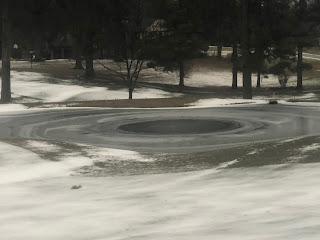Poa Annua
So far it has been a typical spring weather pattern for the tri-state area. We have had cold temperatures followed by hot, almost tropical summer weather, followed by cold and rain. The up and down extreme temperature swings have the turf confused-is it summer or spring? After the tropical hot spell in mid April, some diseases began to form especially in areas comprised of poa annua.
Poa annua (annual bluegrass) is typically a winter annual. Annual bluegrass’ life cycle consists of germination, seed head production, dying out in the summer, and germination again during cooler temperatures. In addition, perennial poa annua biotypes are becoming common and have a slightly different life cycle than the annual types. Seed heads can be produced at extremely low heights making this a very invasive plant on putting surfaces. The heavy amount of shade, due to a generous number of trees, makes the presence of annual bluegrass increase. Right now it is very noticeable because of its spring time seed head production, except on the putting surfaces where the winter PGR applications have kept the seed heads down allowing golf balls to roll far and smooth. Also, poa is very susceptible to disease outbreaks and because of the wet conditions brown ring patch is beginning to show up in some areas. We have applied curative fungicide sprays to combat this issue, but hopefully mother nature will help with dryer and warmer conditions to suppress the disease outbreaks.
 |
| Poa annua seed heads |
 |
| Brown ring patch on #3 green. |
On April 29th the putting greens will be deep tine aerated with 1/2" solid tines (weather dependent). This is done by an outside contractor and we heavily topdress the greens afterwards. This may slow down green speed and make for some bumpy play for a short time until the greens heal. This is a necessary practice to keep the greens healthy, fast, and smooth throughout the hot and humid summer months.
Bunker Removal
The pea sized bunker to the left of #10 fairway was removed. The Green Committee recommended the removal because of the small size and and the rarity of anyone hitting shots into it. The bunker was mounded, so a decent amount of dirt was generated during removal. A bobcat T750 with tacks was rented and all the topsoil was dumped into a bin to be used for future projects. The sod removed from the excavation was used in some bare areas located throughout the golf course. Also, the bunker to the right of #3 green had many dead areas because of the abundant amount of shade in that particular location. Some of the excess sod was used to try and green up the bunker surrounds.
 |
| Bunker to the left of #10 fairway |
 |
| Excavation |
 |
| Taking out the hill |
 |
| Finished product |
 |
| The soil that was saved from the excavation |
 |
| Using some of the sod to help get grass to grow around #3 green bunker. |
Going Green
Since we just celebrated Earth Day, this is a good time to reflect on the many environmental benefits that golf courses, and in particular turfgrasses, provides. According to the USGA and the GCSAA, there are around 16,000 golf courses in the U.S. and they represent less than .1% of all U.S. land. These spaces because of the plant's transpiration process, helps to reduce temperatures in cities that are already hotter due to the urban heat island effect. Also, golf courses help to filter storm water after rain events. The bigger pore space and different soil layers filter debris and pollutants from surrounding areas before it replenishes the existing water table. In addition, turfgrass traps air pollutants, carbon dioxide, and releases oxygen into the atmosphere. According to the Maryland Department of Agriculture (click here for the Maryland professional lawn care article), a 50 foot x 50 foot area of turf produces enough oxygen for a family of 4 and a golf course fairway can sequester 1,500 pounds of carbon per year. Furthermore, the healthier the turf the more carbon it can store. In fact there have been a couple studies (click here for a study by UCDAVIS) showing that grass is more efficient at capturing carbon than trees because unlike woody plants (trees and shrubs) that store carbon in their above ground biomass (trunks, leaves, etc...) grass stores the majority of the carbon in the soil where it can not be released due to decay or fires.
Of course, the downside of a golf course is the amount of maintenance that is involved in the upkeep of turf. At WHCC we strive to use the best management practices available and still meet expectations. Improving water usage, applying less nitrogen, spoon feeding fertilizer applications, returning grass clippings to the turfgrass system, and converting some areas into native pollinator gardens are all procedures we have implemented to help the local environment. However, there is always room for improvement. Converting out-of-play areas to native vegetation, continuing to improve golf course water usage, and perhaps having a conversation about curtailing expectations (example brown grass is sometimes good) can continue to help transform golf courses into an environmentally friendly urban oasis.

































